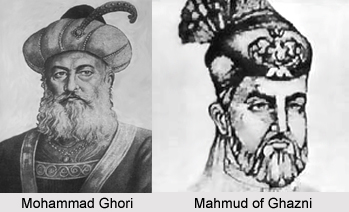 Muslim Rule in India witnessed the emergence of several ruling dynasties who reigned over the subcontinent at successive intervals. The Muslims earlier dominated Kabul, Punjab, and Sind, before intruding into India. The conquest in the Indian subcontinent majorly took place during 5th to 7th centuries. Inter-rivalry and the lack of unity among the rulers paved way for the invaders to establish their dominance in the country. The spread of Islam was one of the chief reasons behind the success of the Muslim conquests.
Muslim Rule in India witnessed the emergence of several ruling dynasties who reigned over the subcontinent at successive intervals. The Muslims earlier dominated Kabul, Punjab, and Sind, before intruding into India. The conquest in the Indian subcontinent majorly took place during 5th to 7th centuries. Inter-rivalry and the lack of unity among the rulers paved way for the invaders to establish their dominance in the country. The spread of Islam was one of the chief reasons behind the success of the Muslim conquests.
715 A.D. witnessed the first invasion on India in Sindh by the Arabs led by Mohammad Bin Qasim. They dethroned Raja Dahir who ruled Sindh from his capital Deval. The Arabs also made efforts to attack Malwa. The next invasion was led by Turk Sabuktagin who established his rule in Khorasan and extended it to Kabul and Ghazni. In 986 AD he waged war on Raja Jaipal of Bathinda. In 991 A.D. Raja Jaipal joined hands with several Hindu rulers like Rajyapala, the Pratihara king of Kannauj and Dhanga, the ruler of the distant Chandela kingdom against Sabuktagin but were defeated. In 997 A.D. Sabuktagin was succeeded by his elder son Mahmud of Ghazni, a religious fanatic who made one of the most impactful influences on the country.
Mahmud of Ghazni
Mahmud of Ghazni, born on 1st November 971 A.D., was the ruler of the Ghaznavi dynasty. He was crowned as the first sultan of the Ghaznavid dynasty in Afghanistan. Lured by the wealth of India and driven by the lust to amass it, Mahmud invaded India almost seventeen times from 1001-1027 A.D. His first major operation commenced in 1001 AD. when he invaded Punjab and the north-eastern region of India. He invaded Thaneshwar, Kangra, Mathura, Kanauj, Kashmir, Gwalior and Punjab between 1009 A.D and 1026 A.D. In 1025 A.D Mahmud invaded the famous Somnath temple and looted enormous treasure of the fortified temple. 1027 A.D. witnessed his last attack. The unbeaten commander possessing the virtues of a leadership died in 1030 A.D.
Muhammad Ghori
Sultan Shahab-ud-Din Muhammad Ghori, born in 1162, laid the foundation of Muslim rule in India. Upon capturing the city of Ghazna, he came to power. A detailed research of the history of India states that Ghori had invaded India almost seven times and his incessant attacks made a deep seated impact on the country. In 1175 A. D. Muhammad fought his first battle against the Muslim rulers of Multan in which he remained victorious. He attempted the conquest of Gujarat In 1178 A.D but was strongly resisted by Bhimdev II who inflicted a crushing defeat on him. He met Prithviraj Chauhan in the first battle of Tarain in 1191 A.D. but was defeated. Severely wounded he left the battlefield but the next year in 1192 A.D. both the armies met again at second battle of Tarain. This time Mohammad defeated Prithvi Raj Chauhan.
In 1194 AD Mohammad Ghori defeated the ruler of Kannauj, Jaichand and captured Benares (Varanasi). Gwalior, Gujarat and Ajmer in 1197 AD. Mohammad Ghori died in 1206 A.D. and was buried in Damik, Jhelum District, present day in Pakistan.



















